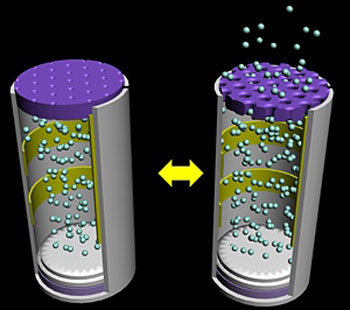| Apr 13, 2011 |
Smart nanomembrane for pulsatile drug delivery
|
|
(Nanowerk News) Pulsatile drug delivery devices can provide controlled and long-term release of drugs in the body under the action of an external stimulus, offering the promise of new treatments for chronic diseases that require daily injections or precise doses of toxic medication. In a new development for such biomedical devices, Jin Kon Kim from the Pohang University of Science and Technology in Korea and colleagues have designed a porous membrane that stores and releases drug molecules according to an external electric signal ("Electrically actuatable smart nanoporous membrane for pulsatile drug release").
|
 |
| Schematic illustration of an electrically activated drug delivery device. In the reduced state (left), the pores are closed due to the expansion of the membrane. In the oxidized state (right), the pores open to release the device's drug payload.
|
|
Many materials that deliver drugs in response to ultrasound, light and magnetic signals have been developed. However, activating these materials typically requires the use of large or specialized equipment. Electrical signals, on the other hand, are easy to generate and control. These signals could also facilitate feedback and remote control outside the body when the drug delivery system is coupled with a sensor or a microchip.
|
|
The porous membrane developed by Kim's team is based on an aluminum oxide membrane with pores of around 400 nm in diameter. Onto this the team deposited a thin layer of gold, and finally a conducting polymer (PPy) containing negatively charged dodecylbenzenesulfonate (DBS) ions.
|
|
The researchers discovered that changes in the electrochemical state of the PPy/DBS membrane affected the opening of its pores — a behavior they could exploit to regulate the release of entrapped compounds (see image). According to Kim, the counterions that bind to the negatively charged membrane play an important role in the opening/closing of the pores by maintaining the neutrality of the PPy chains at each state. "In an oxidation state, the chains shrink because the counterions are expelled, causing the pores to open," he says. "In a reduction state, the volume of the chains increases, and the pores close."
|
|
Moreover, the team found that, unlike for other electrically responsive materials, they could very quickly and reversibly switch from one state to another more than 1,000 times. They also managed to load the membrane with large amounts of a model protein drug.
|
|
The researchers are currently developing pulsatile drug delivery implants made of biodegradable polymers to eliminate the need for post-treatment surgery.
|

